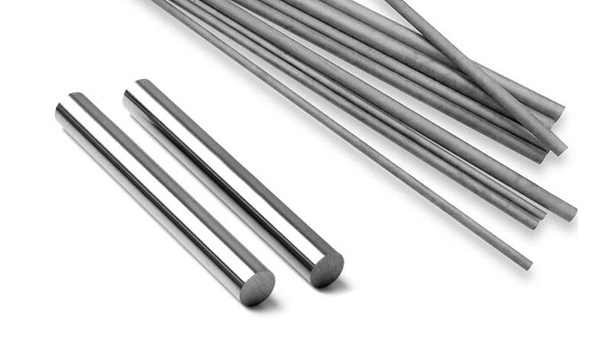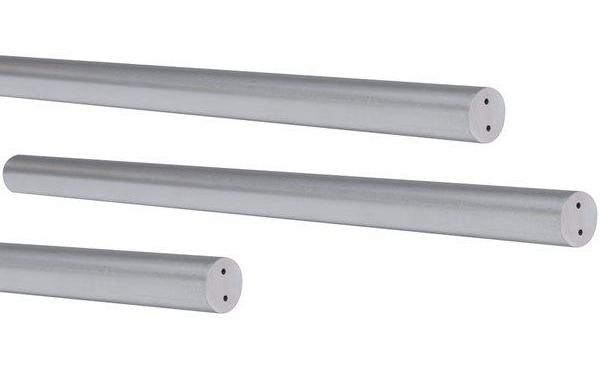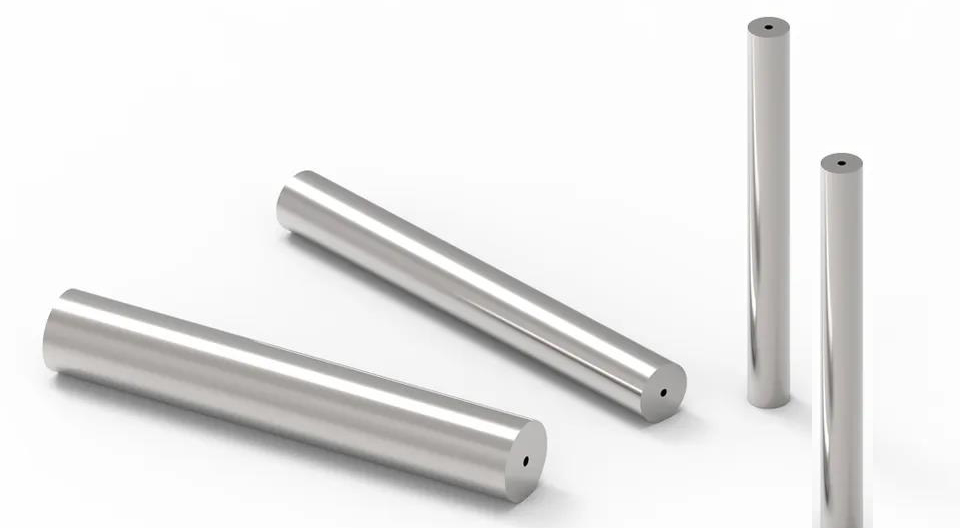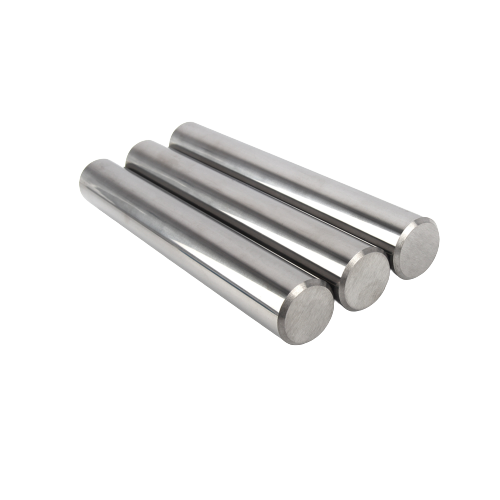公差がミクロン単位で計測され、性能が最重要視される高精度加工の世界、 堅実 カーバイド ロッド が君臨しています。驚くほど硬く、耐摩耗性に優れたタングステンカーバイドで作られたこの驚異的な製品は、航空宇宙から医療まで幅広い産業を支える無数の切削工具や摩耗部品の骨格を形成しています。
しかし、すべての超硬棒が同じように作られているわけではありません。この包括的なガイドでは、超硬棒に不可欠な4つの要素について詳しく解説します。 超硬ソリッドロッド それぞれ、特定の加工課題に合わせたユニークな機能と利点を備えている:
- ストレートクーラントホール 超硬ロッド
- 2 ストレートクーラントホール 超硬ロッド
- 2 ヘリカルクーラントホール 超硬ロッド
- エンド面取り研磨超硬棒
このガイドは、超硬ソリッドロッドの特性を理解することから、多様な用途を探ることまで、超硬ソリッドロッドの世界をナビゲートし、精密加工のニーズに最適なタイプを選択するための知識を提供します。
概要あなたの手に精度の力を
超硬ソリッドロッドは、スチール製とは異なり、極端な高温下でも硬度と強度を維持するため、発熱が懸念される高速加工に最適です。その優れた耐摩耗性は、工具寿命の延長、ダウンタイムの短縮、ひいては製造コストの削減につながります。
クーラントホールの追加やその他の機能により、その性能はさらに向上し、効率的な切りくず排出、熱放散の改善、切削速度の向上が可能になり、精密加工の可能性の限界を押し広げる。
詳しい紹介超硬ソリッドロッドの世界を探る
超硬ソリッドロッドとは?
超硬ソリッドロッドは、その名の通り、超硬材料である炭化タングステンのみで作られた円柱状のロッドで、その卓越した硬度と耐摩耗性で知られています。これらのロッドは、さまざまな産業で使用されるさまざまな切削工具や摩耗部品を製造するための出発材料として機能します。
機械加工における超硬ロッドの動作原理
超硬ロッドは、切削工具に加工される際、以下の原理に基づいて機能します。 せん断変形.棒材から形成される超硬工具の驚くほど硬い刃先は、材料のせん断強度を超えて加工物を切り裂くことができる。切削工具の形状は、切削パラメータとともに、切削の効率と品質を決定します。
超硬ソリッドロッドはどのように使用されるか?
超硬ソリッドロッドは通常、以下のような様々な切削工具に加工される:
- エンドミル シェーピングとプロファイリング作業用。
- ドリル 様々な素材に穴を開ける。
- リーマー: 既存の穴の拡大および仕上げ用。
- カスタムツール: 特定の加工要件に対応。
超硬ソリッドロッドはどのように加工されるのか?
超硬ロッドの加工には、その極めて高い硬度のため、特殊な設備と技術が必要です。超硬ロッドの成形と仕上げには、ダイヤモンド砥石が一般的に使用されます。多くの場合CNC制御の精密研削盤は、高性能切削工具に要求される厳しい公差と複雑な形状を達成するために使用されます。
超硬ソリッドロッドの分類と種類
超硬ソリッドロッドは、以下のような様々な要因に基づいて分類される:
- 超硬グレード: ロッドの硬度、靭性、耐摩耗性を決定する。
- 直径と長さ: 標準サイズから特注サイズまで幅広く対応。
- クーラントホール構成: ストレート、ヘリカル、またはクーラントホールなし。
- 表面仕上げ: 研削、研磨、コーティング。
超硬ソリッドロッドの市場動向
超硬ソリッドロッドの世界的な需要は、特に航空宇宙、自動車、医療などの産業における高度な製造技術の採用増加によって増加傾向にある。同市場は熾烈な競争を特徴としており、メーカー各社は絶えず技術革新を行い、性能とコスト効率を向上させた新しい超硬材種と工具設計を開発している。
超硬ソリッドロッドの4つの主要タイプを公開:比較分析
| 特徴 | 超硬ソリッドロッド | 1 ストレートクーラントホール | 2 ストレート・クーラント・ホール | 2 ヘリカルクーラントホール | 1 端面取りアース |
|---|---|---|---|---|---|
| 画像 | |||||
| 説明 | タングステン・カーバイド製の円筒形の棒。 | 超硬ソリッドロッドの中心を貫く1本の直線状の冷却孔。 | 2つの平行な直線クーラント孔を持つ超硬ソリッドロッド。 | 超硬ソリッドロッドに2つのヘリカルクーラントホールを設け、切屑排出性を向上。 | 一端が面取りされ、精密研削された超硬ソリッドロッドで、正確な工具長設定が可能。 |
| クーラント流量 | なし | スルーツールクーラント | スルーツールクーラント | スルーツールクーラント | なし |
| チップ退避 | 限定 | 改善された | さらなる改善 | スーペリア | 限定 |
| アプリケーション | 汎用機械加工、摩耗部品 | ドリル、リーマ、フライス | 深穴加工、大量加工 | 高性能加工、難削材加工 | 工具ビットブランク、カスタム工具製作 |
| メリット | コストパフォーマンスに優れ、汎用性が高い | 切り屑排出の向上、冷却の改善 | クーラントの流れのバランス、剛性の向上 | 最適な切り屑処理、高速切削 | 正確な工具長、セットアップ時間の短縮 |
| 制限事項 | チップの避難は難しい | 単一のクーラントホールがクーラントの流れを制限する可能性がある | ヘリカルホールはロッドの構造を弱める。 | ストレート・クーラント・ホールより高価 | スルーツールクーラントアプリケーションには適していません。 |
表1:4種類の超硬ソリッドロッドの比較分析




アプリケーション高精度が支配する場所
超硬ソリッドロッドの多用途性は、さまざまな産業における多様な用途に反映されています:
- 航空宇宙 エンジン部品、タービンブレード、構造部品の製造。
- 自動車: エンジン部品、トランスミッションギア、ベアリングの製造。
- メディカルだ: 手術器具、インプラント、歯科器具の製作。
- 金型製作: プラスチック射出成形、ダイカストなどの金型製作。
- エネルギーだ: 石油・ガス探査および発電用の掘削および機械加工部品。
- エレクトロニクス: 電子部品や回路基板の微細加工。
利点と限界:長所と短所の比較
| 特徴 | メリット | 制限事項 |
|---|---|---|
| 硬度と耐摩耗性 | 卓越した硬度と耐摩耗性により、工具寿命の延長と切削性能の向上を実現。 | 衝撃や高振動条件下では脆く、欠けやすい。 |
| 高温安定性 | 高温下でも硬度と強度を維持し、高速加工を可能にする。 | 超硬合金は非常に硬いため、加工には特殊な設備と専門知識が必要です。 |
| 耐食性 | 耐腐食性と耐薬品性に優れ、過酷な環境での使用に適しています。 | 高速度鋼などの他の工具材料よりも高価な場合がある。 |
表2:超硬ソリッドロッドの利点と限界
関連する洞察カーバイドの地平を広げる
- 超硬材種選択の重要性: 適切な超硬材種を選択することは、工具の性能と寿命を最適化する上で極めて重要です。考慮すべき要素には、加工材料、切削速度、送り速度、要求される仕上げ面などがあります。
- 超硬工具の性能におけるコーティングの役割: TiN、TiAlN、ダイヤモンドライクカーボン(DLC)などのコーティングは、超硬工具の耐摩耗性、潤滑性、耐酸化性をさらに高めることができる。
- 超硬棒製造の進歩: 粉末冶金と焼結プロセスにおける革新は、より微細な結晶粒構造や靭性の向上など、特性を改善した新しい超硬合金の開発につながっている。
よくある質問超硬棒に関するお問い合わせ
1.超硬ソリッドロッドと超硬チップの主な違いは何ですか?
超硬ソリッドロッドは切削工具全体の製造に使用され、超硬インサートは工具ホルダーに取り付けられる刃先交換式切削工具である。超硬ソリッド工具は剛性が高く、一般的に高精度の用途に使用され、超硬チップは汎用性とコスト効率を提供する。
2.自分の用途に合ったクーラントホールを選ぶには?
クーラントホールの形状は、加工内容、切削材料、切り屑排出方法によって選択します。ストレートタイプのクーラントホールは汎用加工に適していますが、ヘリカルタイプのクーラントホールは切屑排出が重要な高性能加工に適しています。
3.超硬ソリッド工具は再研磨できますか?
そう、超硬ソリッド工具は何度でも再研磨や再研磨が可能で、寿命を延ばし、工具コストを削減することができる。ただし、超硬合金を損傷させないためには、専用の研削装置と技術を使用することが不可欠です。
4.超硬ソリッドロッドや工具を取り扱う際の安全上の注意点は?
カーバイドは非常に硬く、衝撃で粉々になることがある。超硬合金を取り扱う際は、必ず安全眼鏡、手袋、適切な衣服を着用してください。切りくずは非常に鋭く、高温になることがあるため、超硬合金を加工する際は注意してください。
5.高品質の超硬ソリッドロッドはどこで入手できますか?
評判の良い超硬棒メーカーとサプライヤーは、お客様の特定の要件を満たす高品質の製品を提供することができます。サプライヤーを選択する際には、経験、品質認証、顧客サポートなどの要素を考慮してください。
良い価格で安い炭化タングステンの棒を購入したいですか? これ.




